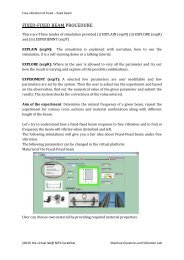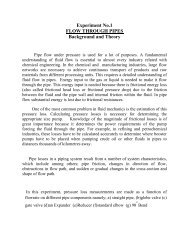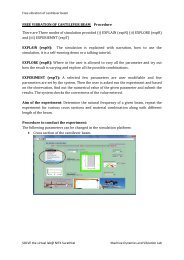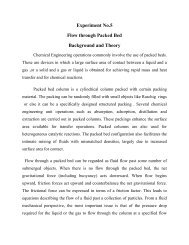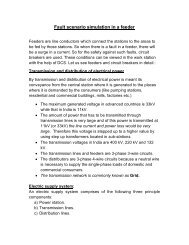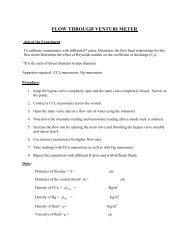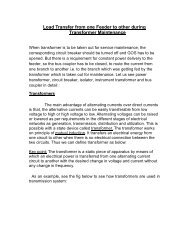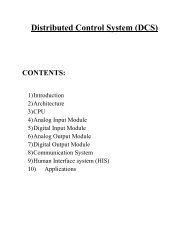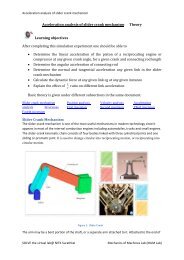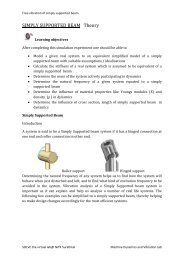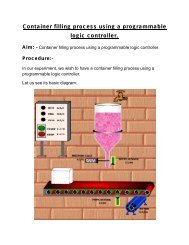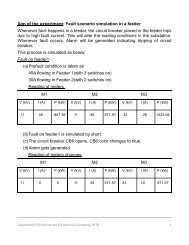The Virtual Lab @ NITK Surathkal, Applied Mechanics & Hydraulics ...
The Virtual Lab @ NITK Surathkal, Applied Mechanics & Hydraulics ...
The Virtual Lab @ NITK Surathkal, Applied Mechanics & Hydraulics ...
Create successful ePaper yourself
Turn your PDF publications into a flip-book with our unique Google optimized e-Paper software.
Consider a beam AB of span ‘l’ subjected to a uniform bending moment M so that the beam deflectsinto an arc of circle. Let the deflection at the centre of the bean be ‘δ ‘. If the beam is of uniform crosssectionthe moment of inertia I of its cross-section will be constant.Using the bending formulaMI= E R; R = EIMSince M, E and I are all constants R will also be a constant and therefore the beam will bend into an arcof a circle.<strong>The</strong> above example reveals an important relation of the flexure theory, i.e.,. <strong>The</strong> radius of curvature Rat any point of the elastic curve of a beam is directly propulsion to the flexural rigidity EI and inverselyproportional to the flexural rigidity EI and inversely proportional to the bending moment.DC. CE = AC. CBδ(2R − δ) = . 2Rδ − δ = Since deflection δ being a small quantity δ can be neglected2Rδ = l 4δ = Using = , = Substituting the value of in the expression for δδ = . ∴ δ = Ml8EILet θA be the slope at end ANow angle AOC = θA.Since θA is a small quantity, sin θA ≅ θA© SOLVE – <strong>The</strong> <strong>Virtual</strong> <strong>Lab</strong> @ <strong>NITK</strong> <strong>Surathkal</strong>, <strong>Applied</strong> <strong>Mechanics</strong> & <strong>Hydraulics</strong>
= sec θ = ( ) = In any practical case of bending of beams, the slope comparisons to unity, hence can be ignored.∴ = is very small and so If M is the bending moment which has produced the radius of curvature R at that point,<strong>The</strong>n = ∴ M = EI is very small inThis is the differential equation of the deflection curves for the beam loaded by lateral forces. This isknown as Eulers-Bernoulli equation and solution of this equation may be obtained by the ‘DoubleIntegration Method’.For curvature, if the curve is concaved forward the positive y-axis,> 0 Since > 0 hence it is taken as positive.Conversely if the curve is concaved towards the negative y-axis then negative.> 0 since < 0, it is taken asFrom the above sign convention it follows that if the coordinate axes are chosen as shown infigure.2.(a) the elastic curve equation may be written in the general form as EI = M© SOLVE – <strong>The</strong> <strong>Virtual</strong> <strong>Lab</strong> @ <strong>NITK</strong> <strong>Surathkal</strong>, <strong>Applied</strong> <strong>Mechanics</strong> & <strong>Hydraulics</strong>
© SOLVE – <strong>The</strong> <strong>Virtual</strong> <strong>Lab</strong> @ <strong>NITK</strong> <strong>Surathkal</strong>, <strong>Applied</strong> <strong>Mechanics</strong> & <strong>Hydraulics</strong>



